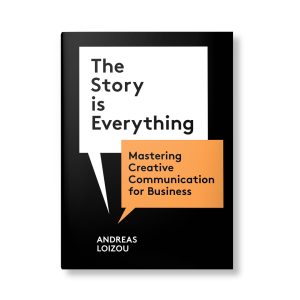By Andreas Loizou
 Writing guru, Andreas Loizou, shares his best secrets in his book The Story Is Everything.
Writing guru, Andreas Loizou, shares his best secrets in his book The Story Is Everything.
God is in the details.
Can you hear the murderous music that plays whenever a shark attack is imminent in Jaws? Do you remember Meg Ryan, lustily enjoying her sandwich during the ‘I’ll have what she’s having’ scene in When Harry Met Sally?

Great examples from adverts, films and novels are all around us. Think of these as the sprinkles of cinnamon or vanilla that make your coffee magical. Listeners love stories that are crafted with skill and care. These are the elements that guarantee that you – and your story – are remembered for all the right reasons.
A is for Authenticity
Authenticity encourages you to show, not tell. You need to display your vulnerability. Give examples of your failures to make your story real for the audience.
B is for Beginning
Avoid the storyteller equivalent of clearing your throat in public. You do need to establish your credibility with the audience, but that’s very different to boring them with a long introduction. Dive in, and they will follow!
C is for Conflict
Conflict is vital for stories. It adds uncertainty to the hero’s journey, so the audience wants to know what happens next. Conflict makes us root for the hero, which creates the emotional connection we need to read the next 400 pages of Stieg Larsson or watch series 5 of Better Call Saul.
D is for Dilemma
Conflict is great, but dilemma is ever better. A dilemma occurs when a character has to choose between two options, both of which come with a significant downside.
The relationship between a parent and a child can be fraught with dilemmas. In Gone Baby Gone, the detective Patrick Kenzie must choose between following the letter of the law (bringing a kidnapped young girl back to her mother) or letting her grow up in a far more supportive and comfortable environment. We stare open-mouthed as the unnamed hero in Bong Joon-ho’s Mother stretches the definition of what a good mother does to protect her son. And in Sophie’s Choice, Zofia Zawistowski faces the absolutely heart-breaking decision between losing her son or her daughter.
E is for Experience
Shared experiences are a great way to connect with the audience. All of us have been a scared child or a newbie in their first job. Whether this was in Oslo or Osaka, in 1943 or this week, the feelings will be the same. Finding common ground with your audience will always endear them to you.
F is for Facts
Jerome Bruner was an expert in the creative process and a cognitive psychologist. He found facts are up to 22 times more memorable when presented in the form of a story. Facts may convince some people some of the time, but stories are much more effective.
G is for Get Them Gripped Then Let Them Go
A story that is solely comprised of low moments (failure of a product launch, being taken over by an penny-pinching private equity fund) will be depressing. But a story that is all high moments (a brand conquers a continent, a successful strategy is implemented without problem) will also be unbearable. Stories need tension and release, ups and downs, darkness and light…well, you get the picture.
H is for Hardwired
The default setting of the human brain is story. I can’t stress this enough. Humans love stories and they want to enjoy listening to you tell yours. An audience will prefer a nervous speaker who tells a tale to a super-confident presenter who rattles through one slide after another.
I is for Introduction
My name is X, I’ve been at Y for Z years…stop!
I’m so happy to have been invited to speak at…stop!
As far back as I can remember, I always wanted to be a gangster…go!
Henry Hill, the main protagonist of Goodfellas, doesn’t mention his stakeholders, his lifestyle ambitions or his passion for the more informal parts of the hospitality industry. Ditch the corporate and conventional in favour of story. Begin the story with the real you, not your LinkedIn profile.

J is for Journey
You kinda guessed this one, didn’t you? I’ll tell you all about the Hero’s Journey in my next book.
K is for Knowledge Of Self
Being the hero of our own life is a vital element of the human psyche. Once you realise that every single member of your audience is on their own personal journey, your storytelling changes. Age, cultural background and gender are all irrelevant, for each person is their own hero. Customers will always care more about their story than yours.
L is for Loss
We often frame what’s at stake in terms of what the audience can gain. Flip it round, and you can focus on what the audience or customer will lose if they’re not successful. John McClane in Die Hard has to foil the terrorists but his true motivation is to avoid his own death. He’s not Rambo or the Terminator, but a man who just wants to patch things up over Christmas with his estranged wife.
Telling clients what they can miss out on is an effective, if occasionally dangerous, tactic. I recommend that if you mention failure (the loss) you make it clear how you help people avoid it (and gain success).
M is for Message
You may have created the best product or service the world has ever seen, but no one gives a damn unless you can communicate the benefits you offer to the consumer. Too much business storytelling is about the company rather than the consumer. I don’t care about a company’s share price or that its logistics hub is based in Rotterdam. But I do want to know how spending my hard-earned money will make me feel better.
Your message needs to simple and relevant. It’s got to be something one happy customer can tell to another.
N is for Noise
Human beings are always looking for shortcuts. We’re bombarded with information and hounded by adverts every second of our day. A company that helps a consumer cut through noise with a sharply-constructed message will always do well.
Ronseal gives us a genius example in six words: Does What It Says On The Tin. The phrase positions their products as unintimidating, reliable and simple to use. The company acknowledges that not everyone painting a fence this weekend is an expert builder, but as heroes in our own story, we like the feeling of making a better home for us and our loved ones. We will choose products that help this happen.
Does What It Says On The Tin strikes a big chord. It’s moved from the advert into everyday usage to describe things – a holiday hotel, a style of politics – that are reliable. There’s even a song by Katie Melua called What It Says On The Tin. I suspect, however, that the lyrics were inspired more by the vast number of words that rhyme with tin – bin, sin, begin, win – rather than any profound love of DIY.

O is for Oh, I Can’t Think Of Anything
I wonder if any of you skim readers will notice?
P is for Pictures
Specific details create images in people’s minds. Vivid details give you credibility, because they convince the audience you were there. Imagery fires up their imagination. Sight is the dominant sense for most people around the world: we tend to interpret the world primarily through our eyes. Details give an ‘I was there’ veracity to your storytelling.
Q is for Quick
As a general rule of thumb, no one will ever ask you to make your presentation longer or more complex. Be quick in all you do.
This is especially true online, where the rejection statistics are brutal. Your customers must be able to tell what you do before they even reach your website.
R is for Return
Stories often end with the hero returning home. They have been changed by their time in the unfamiliar world: the skills and attributes they learned there are much more apparent now they’re back home.
S is for Senses
Good authors plant strong visuals in the audience’s brains. Great storytellers appeal to all the senses. Add tastes, smells and sounds to your story to make it come alive.
T is for Takeaway
Audiences love to summarise. West Side Story is Romeo and Juliet in 1950s New York, Alien is Jaws in Space, Snakes On A Plane is, well, basically snakes on a plane.
Without lecturing or preaching, use your storytelling skills to show your takeaway. Can you provide the audience with a single message, clear and unequivocal, they can pass on to their friends?
U is for Universal Stories
You know that Pretty Woman is Cinderella, right? And that Frozen bears more than a passing resemblance to Beauty And The Beast?
Certain themes are common to stories. These include the thirst for power, the need for security and the quest for love. You know you’ve written a successful story when it can be pared back to a single emotional need.
V is for Villain
With all this talk about heroes, the villains have escaped our attention. Make your opponent worthy of your hero. You build a three-dimensional antagonist by explaining their motivation: are they desperate for market share, or righting a perceived wrong, or fighting for their own cause?
Don’t make them an ogre who just likes doing bad things. They must exist in their own right and as a foil to the hero. Acknowledge their importance to the story. Without Moriarty, Sherlock Holmes is just a fading detective with a penchant for Class A’s.
V is also for Voice
Nailing down your storytelling voice takes time and effort, but it will make you a unique presenter. But voice – in writing, presenting, acting, speech-making – is a paradox.
A unique voice makes you stand out in a world jammed full of content and noise, but try too hard and you will come across as bogus. We all wear masks at work to separate our personal and professional selves, but readers and listeners demand us to be authentic.
A further contradiction is that a successful voice depends on both consistency and change. Fans and followers will love you because they recognise your style from the first words of the podcast, or the opening paragraph of your article. But your voice will develop the more you speak.
W is for Write Every Day
Sound advice. You’ve got to keep practising and challenging yourself, because no one gets to learn it all.
X is for X
No, I’m not going to shoehorn-in the word eXciting to this list.
Y is for You
A serious point here. This essay contains lots of advice, practical tips and hints on mindset. But it’s very important to avoid anything that makes you feel phony or fake. Keep what works for you, ignore what doesn’t. If you find a suggestion doesn’t chime with you, ignore it. There’ll be another one along in a minute.
Z is for Zeds
Remember what your presentations used to be like? Lights, camera, painfully dull slide deck? Those days are over, so never again will you hear the yawns and snores of your late-afternoon audience.
*****
The Story Is Everything is published by Laurence King Publishing, Quercus. You can find out more by clicking here and visiting the LKP website: laurenceking.com/blogs/blog/5-ways-to-use-your-senses-in-storytelling.
About The Author
FT Prentice Hall published Andreas’ novel, The Devil’s Deal. Translation rights were sold in nine territories, including China, Korea and Japan. He set up the Margate Bookie in a single room in a disused warehouse in 2015. This charity has now grown to host writing workshops, book groups, literary walks and an amazing annual festival.
A version of this article won the annual award for writing at IE Business School in Madrid.
*****
Read the latest issue of Write On! (13) magazine online here.
You can hear great new ideas, creative work and writing tips on Write On! Audio. Find us on all major podcast platforms, including Apple and Google Podcasts and Spotify. Type Pen to Print into your browser and look for our logo or find us on Anchor FM.
*****
If you or someone you know has been affected by issues covered in our pages, please see the relevant link below for information, advice and support: https://pentoprint.org/about/advice-support/



